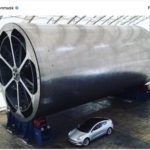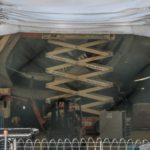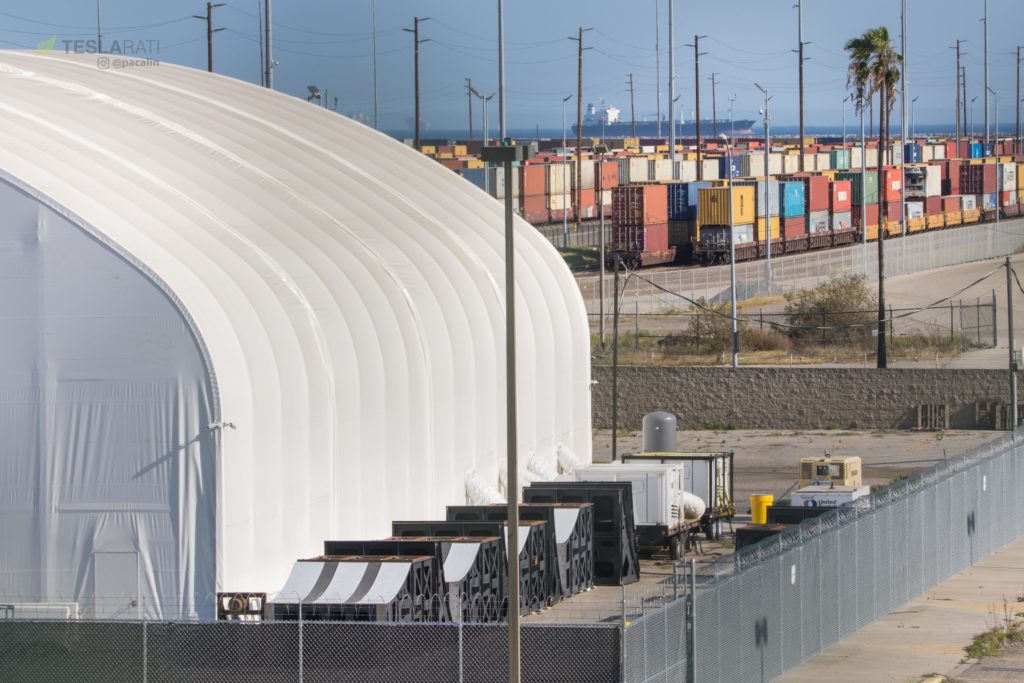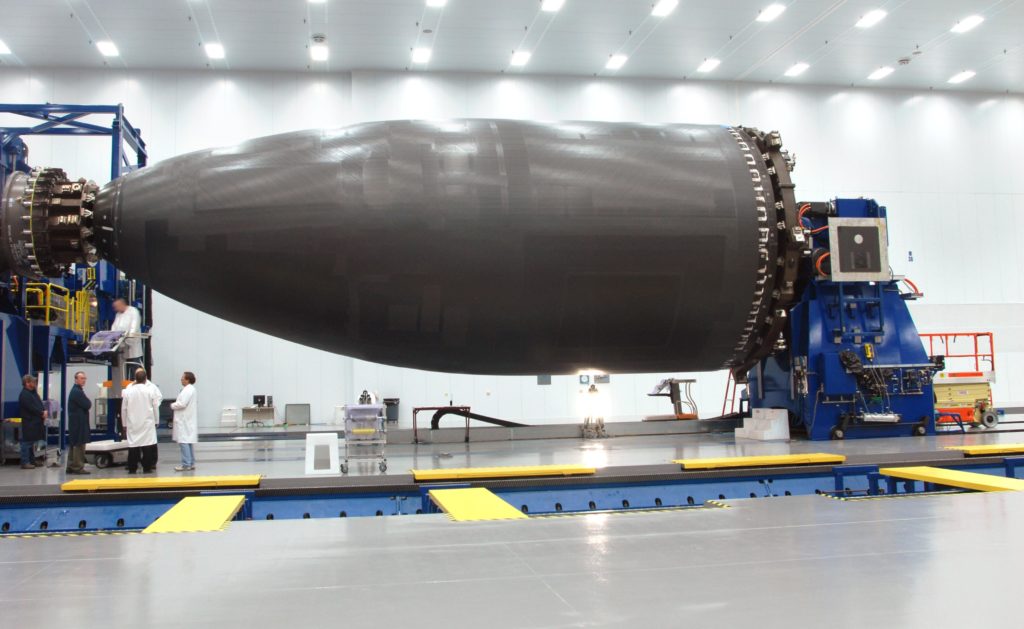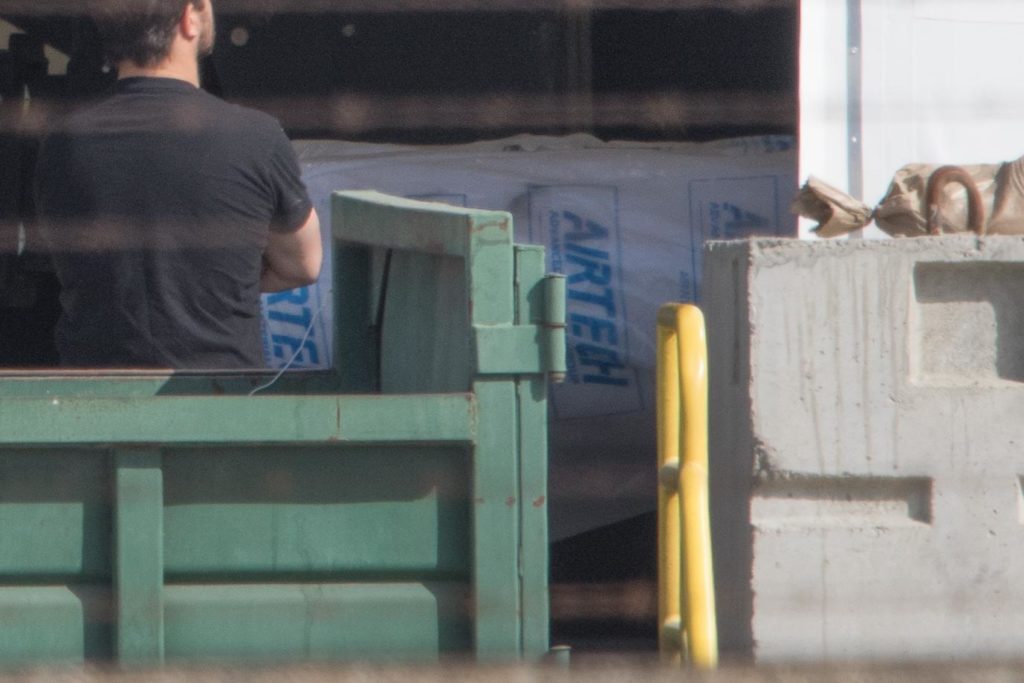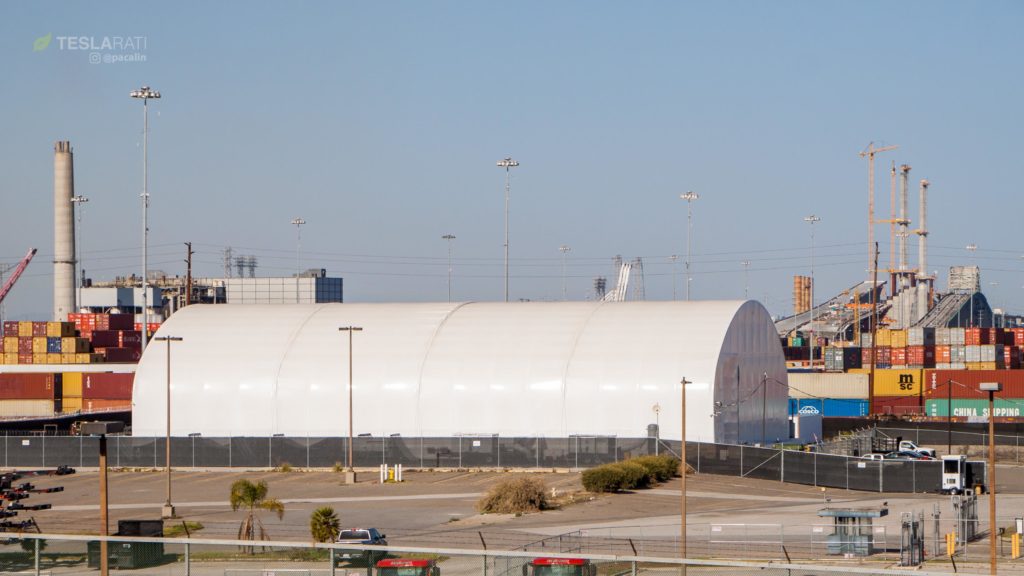
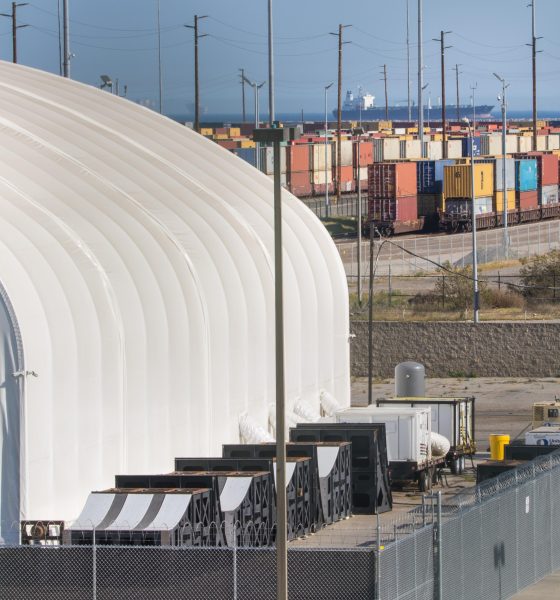
News
SpaceX moving fast on Mars rocket development, BFR tent spied with more tooling
Photos taken by Teslarati photographer Pauline Acalin have confirmed that SpaceX’s massive Mars rocket fabrication tooling has been hiding in plain sight at the company’s Port of San Pedro tent facility.
Spotted inside the temporary structure thanks to open flaps and a human desire for a breeze amidst the warm Los Angeles springtime, the main cylindrical component is truly vast – large enough that the eye almost glazes over it at first glance. Dwarfing the humans clambering about it, very rough estimates using knowledge of the tent’s reported area (20,000 square feet) and size comparisons with machinery blueprints suggest a diameter of around 8-10 meters (26-36 feet), loosely conforming to the expected 9m diameter of BFR, as of CEO Elon Musk’s IAC 2017 update. Recently, however, President Gwynne Shotwell showed off an updated Mars rocket video at TED2018 that led to Musk hinting that BFR may have grown slightly since then.
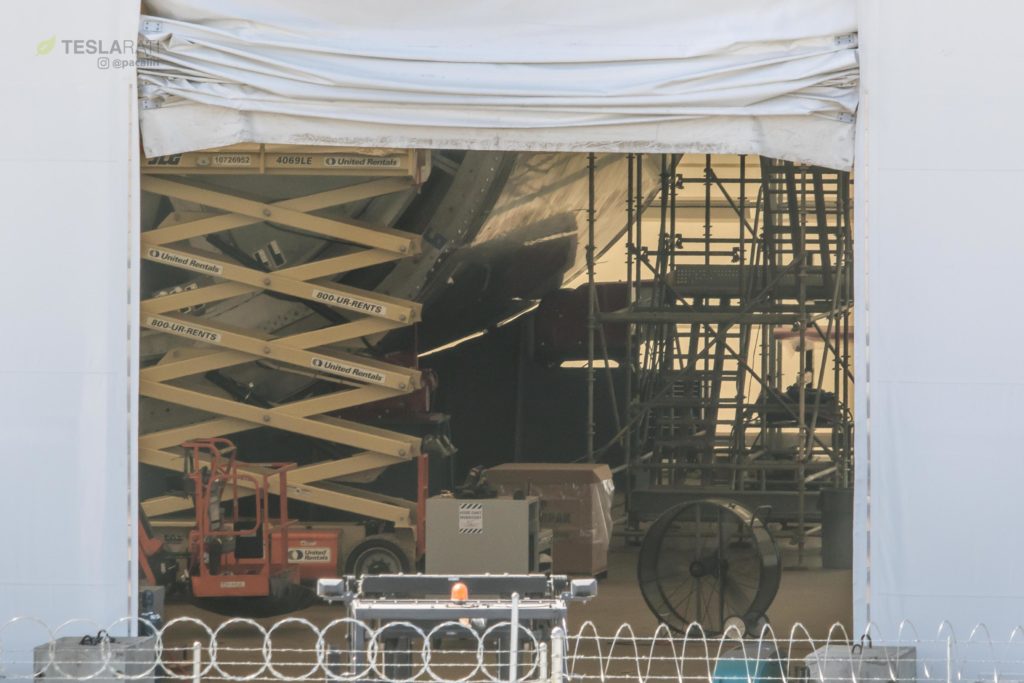
SpaceX’s massive BFR manufacturing tool peeked out from the company’s Port-side tent facility. (Pauline Acalin)
- SpaceX’s BFR tent and mandrel, caught on April 14th. (Pauline Acalin)
- Like, really big. (Pauline Acalin)
The massive cylindrical structure teased by Musk earlier this month is most likely a mandrel, a tool that can be spun on its horizontal axis to weave predetermined structures. In the case of the Mars rocket mandrel, it will likely be used to carefully wind dozens or hundreds of layers of carbon fiber (known as prepreg), interspersed with layers of laminate and various epoxies and resins. It’s also possible, however, that the massive tool is instead a multipurpose mold and autoclave, where the composite layers would be lain on the inside of the cylinder, allowed to set, and eventually sealed inside and heat/pressure treated.
Images of the machinery are fairly ambiguous: they show a structure that could have connection points one might find on an autoclave, as well as what appears to be a thick and well-insulated internal wall. However, the external skin appears to be a relatively thin sheet of metal, which would point more towards a traditional composite mandrel, where certain sheets could be removed or modified as needed to create desired shapes in the composite while it’s being formed, less risky than machining a completed segment.
- Just a casual line of car-sized steel segments hanging around outside the BFR tent. (Pauline Acalin)
- While unclear, these are likely sections of a layup or mold that will be used to form BFR’s more complex composite components. (Pauline Acalin)
- Shown is the forward fuselage of the 787 on a mandrel for composite weaving and layup.(Boeing)
Perhaps even more interesting, a number of massive metal structures were spotted just outside of the tent. While it is unclear what exactly their purpose was, is, or will be, it’s more likely than not that they are components of a carbon composite mold or layup structure meant to deal with fabrication of certain Mars rocket and spaceship components with complex curves, versus the relatively simple cylinders that BFR and BFS are largely comprised of. Still, precedents exist in large aerospace composite manufacturing for the fabrication of structures with complex curves, most notably the nose and front sections of airliners like Boeing’s 787.
Finally, it’s worth noting just how shockingly busy the BFR tent was on both April 13th and 14th, as well as the 8th (the first day Pauline visited the facility). With upwards of 40 cars parked at the tent, it’s blindingly clear that SpaceX is not simply using the tent as a temporary storage location – alongside the arrival of composite fabrication materials (prepreg sheets, epoxy, etc) from Airtech International, SpaceX undeniably intends to begin initial fabrication of the first BFR prototypes in this tent, although they will likely eventually move the activities to the Berth 240 Mars rocket factory. That’s certainly not a sentence I ever expected to write, but it is what it is.
- Airtech supplies arrive at the BFR tent on April 14. Airtech is a composites supplier with a branch located just miles away from Port of San Pedro. (Pauline Acalin)
- Lots of cars at the BFR tent. This also provides a sense of scale for the tent’s absolutely massive access flaps. (Pauline Acalin)
- April 2018. (Pauline Acalin)
SpaceX’s giant, temporary tent currently housing the company’s BFR/BFS fabrication tooling while their permanent facility awaits construction a couple miles away. #SpaceX #BFR pic.twitter.com/a8Tj6QLmUz
— Pauline Acalin (@w00ki33) April 15, 2018
Follow us for live updates, behind-the-scenes sneak peeks, and a sea of beautiful photos from our East and West coast photographers.
Teslarati – Instagram – Twitter
Tom Cross – Twitter
Pauline Acalin – Twitter
Eric Ralph – Twitter

Elon Musk
Starlink passes 9 million active customers just weeks after hitting 8 million
The milestone highlights the accelerating growth of Starlink, which has now been adding over 20,000 new users per day.

SpaceX’s Starlink satellite internet service has continued its rapid global expansion, surpassing 9 million active customers just weeks after crossing the 8 million mark.
The milestone highlights the accelerating growth of Starlink, which has now been adding over 20,000 new users per day.
9 million customers
In a post on X, SpaceX stated that Starlink now serves over 9 million active users across 155 countries, territories, and markets. The company reached 8 million customers in early November, meaning it added roughly 1 million subscribers in under seven weeks, or about 21,275 new users on average per day.
“Starlink is connecting more than 9M active customers with high-speed internet across 155 countries, territories, and many other markets,” Starlink wrote in a post on its official X account. SpaceX President Gwynne Shotwell also celebrated the milestone on X. “A huge thank you to all of our customers and congrats to the Starlink team for such an incredible product,” she wrote.
That growth rate reflects both rising demand for broadband in underserved regions and Starlink’s expanding satellite constellation, which now includes more than 9,000 low-Earth-orbit satellites designed to deliver high-speed, low-latency internet worldwide.
Starlink’s momentum
Starlink’s momentum has been building up. SpaceX reported 4.6 million Starlink customers in December 2024, followed by 7 million by August 2025, and 8 million customers in November. Independent data also suggests Starlink usage is rising sharply, with Cloudflare reporting that global web traffic from Starlink users more than doubled in 2025, as noted in an Insider report.
Starlink’s momentum is increasingly tied to SpaceX’s broader financial outlook. Elon Musk has said the satellite network is “by far” the company’s largest revenue driver, and reports suggest SpaceX may be positioning itself for an initial public offering as soon as next year, with valuations estimated as high as $1.5 trillion. Musk has also suggested in the past that Starlink could have its own IPO in the future.
News
NVIDIA Director of Robotics: Tesla FSD v14 is the first AI to pass the “Physical Turing Test”
After testing FSD v14, Fan stated that his experience with FSD felt magical at first, but it soon started to feel like a routine.

NVIDIA Director of Robotics Jim Fan has praised Tesla’s Full Self-Driving (Supervised) v14 as the first AI to pass what he described as a “Physical Turing Test.”
After testing FSD v14, Fan stated that his experience with FSD felt magical at first, but it soon started to feel like a routine. And just like smartphones today, removing it now would “actively hurt.”
Jim Fan’s hands-on FSD v14 impressions
Fan, a leading researcher in embodied AI who is currently solving Physical AI at NVIDIA and spearheading the company’s Project GR00T initiative, noted that he actually was late to the Tesla game. He was, however, one of the first to try out FSD v14.
“I was very late to own a Tesla but among the earliest to try out FSD v14. It’s perhaps the first time I experience an AI that passes the Physical Turing Test: after a long day at work, you press a button, lay back, and couldn’t tell if a neural net or a human drove you home,” Fan wrote in a post on X.
Fan added: “Despite knowing exactly how robot learning works, I still find it magical watching the steering wheel turn by itself. First it feels surreal, next it becomes routine. Then, like the smartphone, taking it away actively hurts. This is how humanity gets rewired and glued to god-like technologies.”
The Physical Turing Test
The original Turing Test was conceived by Alan Turing in 1950, and it was aimed at determining if a machine could exhibit behavior that is equivalent to or indistinguishable from a human. By focusing on text-based conversations, the original Turing Test set a high bar for natural language processing and machine learning.
This test has been passed by today’s large language models. However, the capability to converse in a humanlike manner is a completely different challenge from performing real-world problem-solving or physical interactions. Thus, Fan introduced the Physical Turing Test, which challenges AI systems to demonstrate intelligence through physical actions.
Based on Fan’s comments, Tesla has demonstrated these intelligent physical actions with FSD v14. Elon Musk agreed with the NVIDIA executive, stating in a post on X that with FSD v14, “you can sense the sentience maturing.” Musk also praised Tesla AI, calling it the best “real-world AI” today.
News
Tesla AI team burns the Christmas midnight oil by releasing FSD v14.2.2.1
The update was released just a day after FSD v14.2.2 started rolling out to customers.

Tesla is burning the midnight oil this Christmas, with the Tesla AI team quietly rolling out Full Self-Driving (Supervised) v14.2.2.1 just a day after FSD v14.2.2 started rolling out to customers.
Tesla owner shares insights on FSD v14.2.2.1
Longtime Tesla owner and FSD tester @BLKMDL3 shared some insights following several drives with FSD v14.2.2.1 in rainy Los Angeles conditions with standing water and faded lane lines. He reported zero steering hesitation or stutter, confident lane changes, and maneuvers executed with precision that evoked the performance of Tesla’s driverless Robotaxis in Austin.
Parking performance impressed, with most spots nailed perfectly, including tight, sharp turns, in single attempts without shaky steering. One minor offset happened only due to another vehicle that was parked over the line, which FSD accommodated by a few extra inches. In rain that typically erases road markings, FSD visualized lanes and turn lines better than humans, positioning itself flawlessly when entering new streets as well.
“Took it up a dark, wet, and twisty canyon road up and down the hill tonight and it went very well as to be expected. Stayed centered in the lane, kept speed well and gives a confidence inspiring steering feel where it handles these curvy roads better than the majority of human drivers,” the Tesla owner wrote in a post on X.
Tesla’s FSD v14.2.2 update
Just a day before FSD v14.2.2.1’s release, Tesla rolled out FSD v14.2.2, which was focused on smoother real-world performance, better obstacle awareness, and precise end-of-trip routing. According to the update’s release notes, FSD v14.2.2 upgrades the vision encoder neural network with higher resolution features, enhancing detection of emergency vehicles, road obstacles, and human gestures.
New Arrival Options also allowed users to select preferred drop-off styles, such as Parking Lot, Street, Driveway, Parking Garage, or Curbside, with the navigation pin automatically adjusting to the ideal spot. Other refinements include pulling over for emergency vehicles, real-time vision-based detours for blocked roads, improved gate and debris handling, and Speed Profiles for customized driving styles.

